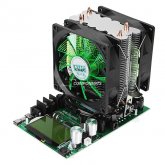I have the 180W model shown below. It also has a voltage difference of 0.42mv between cell actual voltage and that seen at the test terminals. I'm using 14g fine copper with crimped ends.
There is a calibration setting but I never played with that as the docs discourage it... Instead, I reset the cutoff to 2.0V which triggers at 2.48V and after the cell settles back up to roughly 2.52-2.55. This is after a constant 20A load test running for 14 hours (doing it on 280AH EVE's.)
I've attached the manual to mine, in case it may be of help.
I just noticed, these guys just came out with one that has logging for PC Serial Port capture... bugger
View attachment 31775
Those are the same docs that came with mine. If by ‘discourage it’ you mean the Note at the end of the Description:
‘(Note: Please don’t calibrate the voltage or current if without standard instruments)’
I’d hardly call that ‘discouraging it.
The real issue is there is no explanation for how to perform calibration other than the one reference to ‘current data reset to zero (0.00A).’
Of course the lack of any instruction
is very discouraging - who’d want to risk screwing up their unit bumbling through control menus without any guidance at all.
There are some YouTube videos hinting at how to calibrate a similar-looking unit so I’d hoped someone on the Forum had cracked the code, but looks like we’re all in the same ‘if it ain’t broke, don’t fix it’ (ie: discouraged) boat.
From my understanding, the only difference between my 150W unit and your 180W unit is the size of the heat sink and the fan, so if you are able to sustainably test successfully at 20A, heat sounds more likely to be responsible for folks burning their 150W units out rather than current of 20A.
There is a setting for Max Power and my 150W unit came preset at 180W. Anyone using a 150W unit without adjusting their Power Limit setting to 150W risks frying their transistors from too much heat.
The final Warning is pretty clear on this:
‘5) Be sure to obey the law of conservation of energy, the product of the voltage and the current should be less than 150W.’



